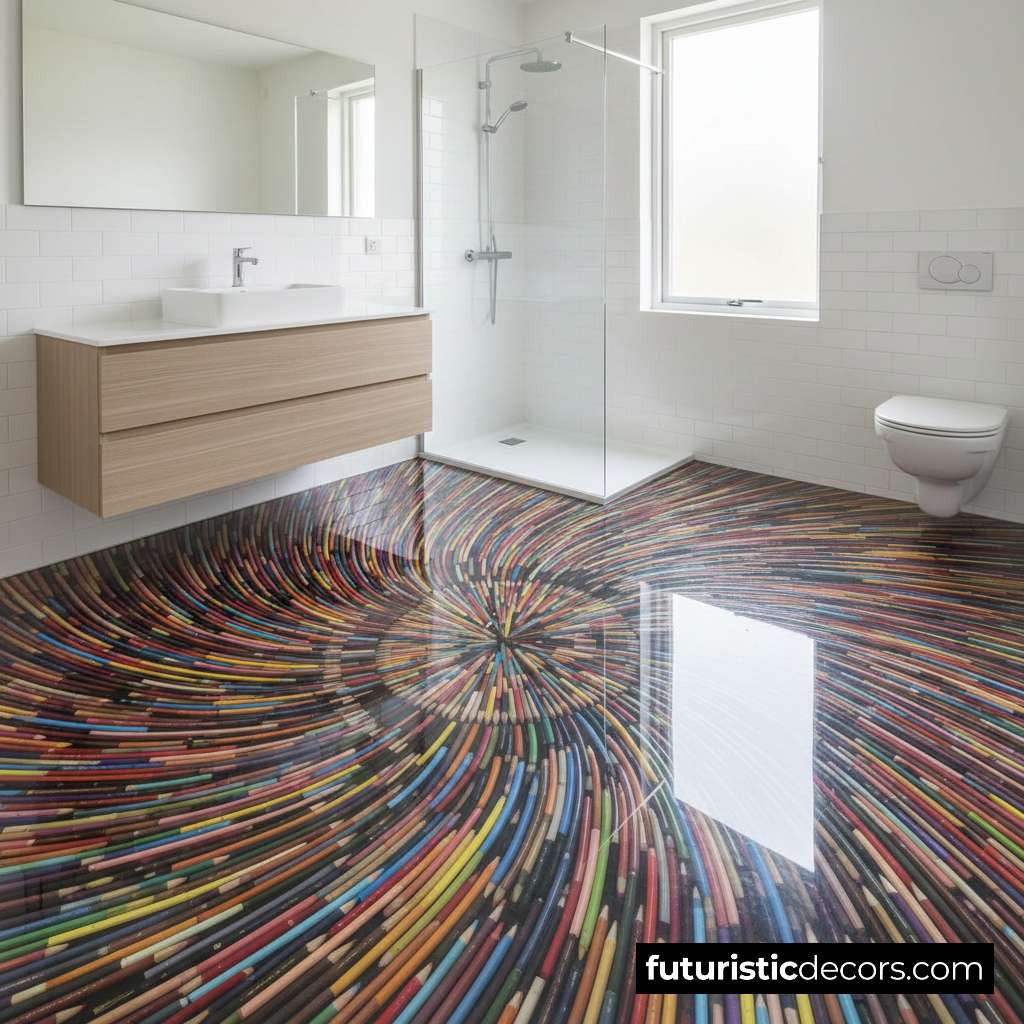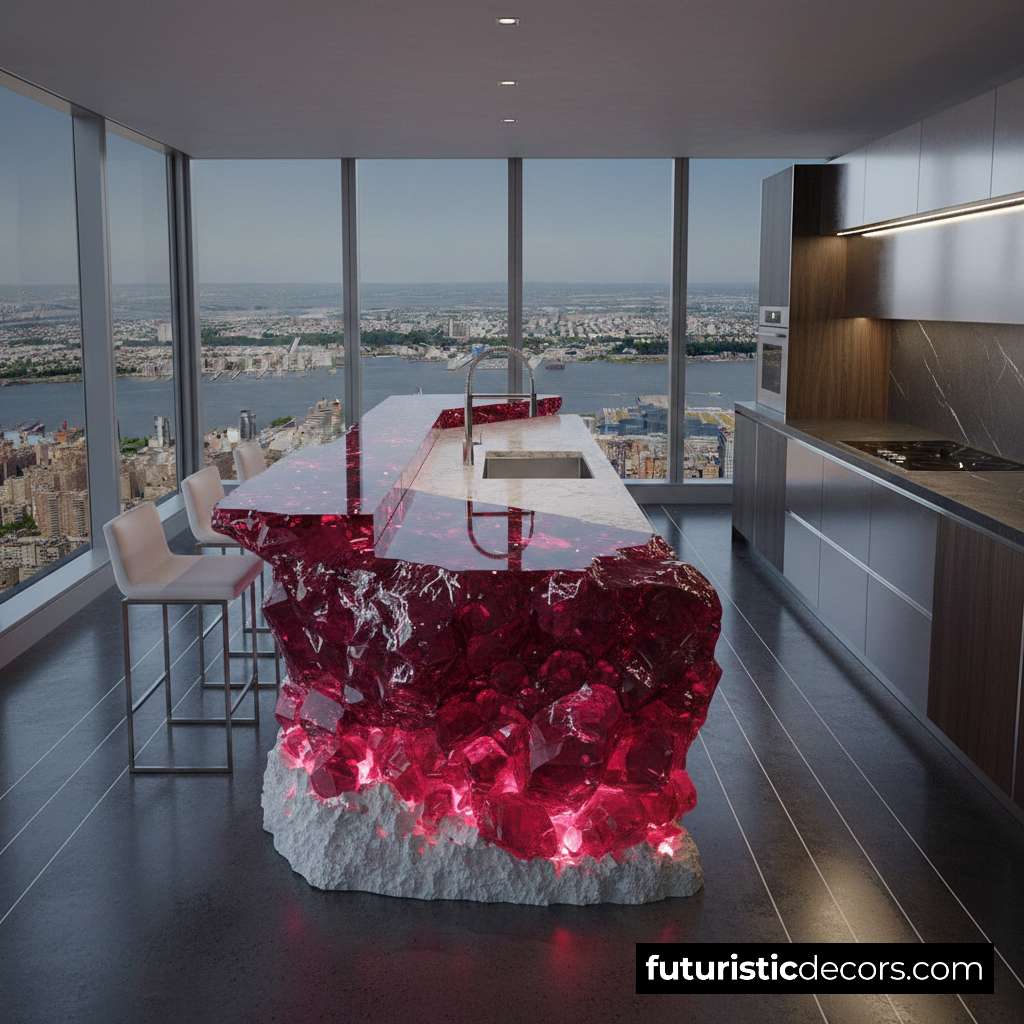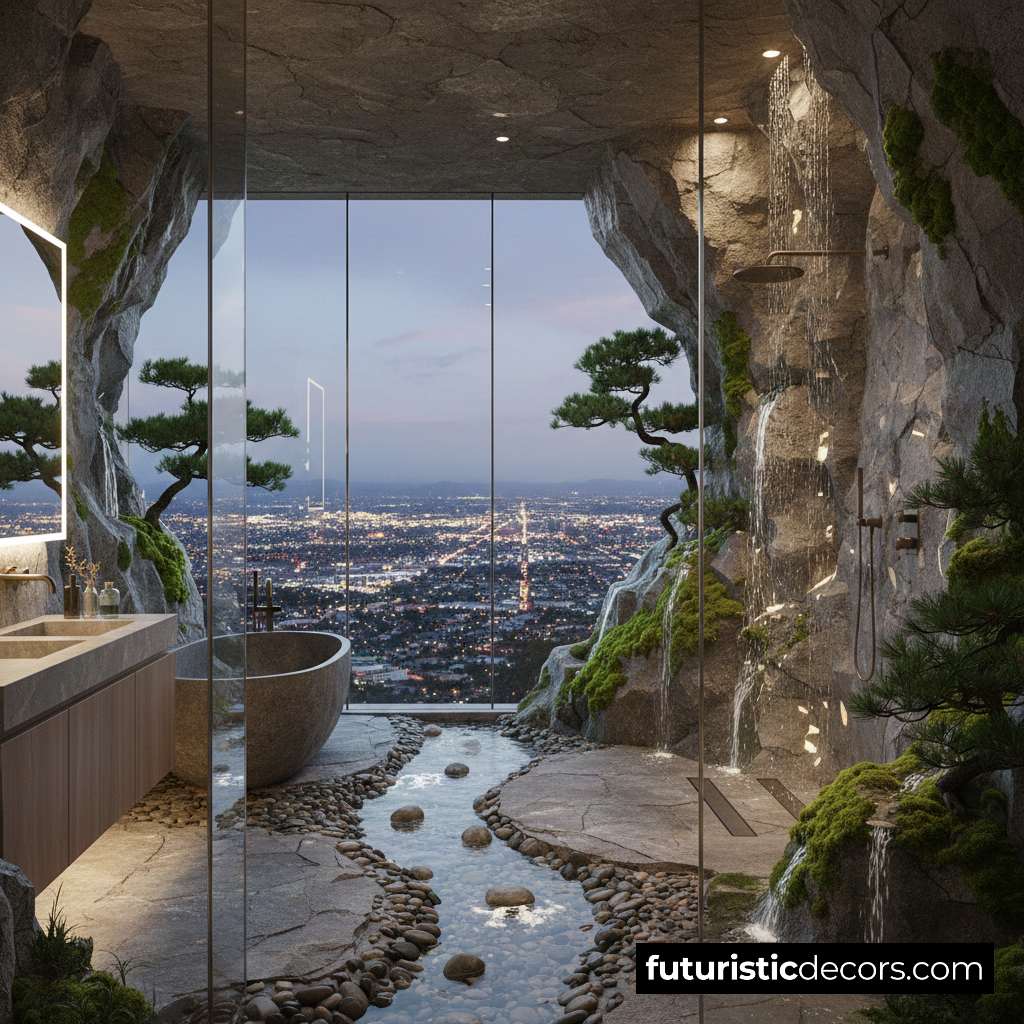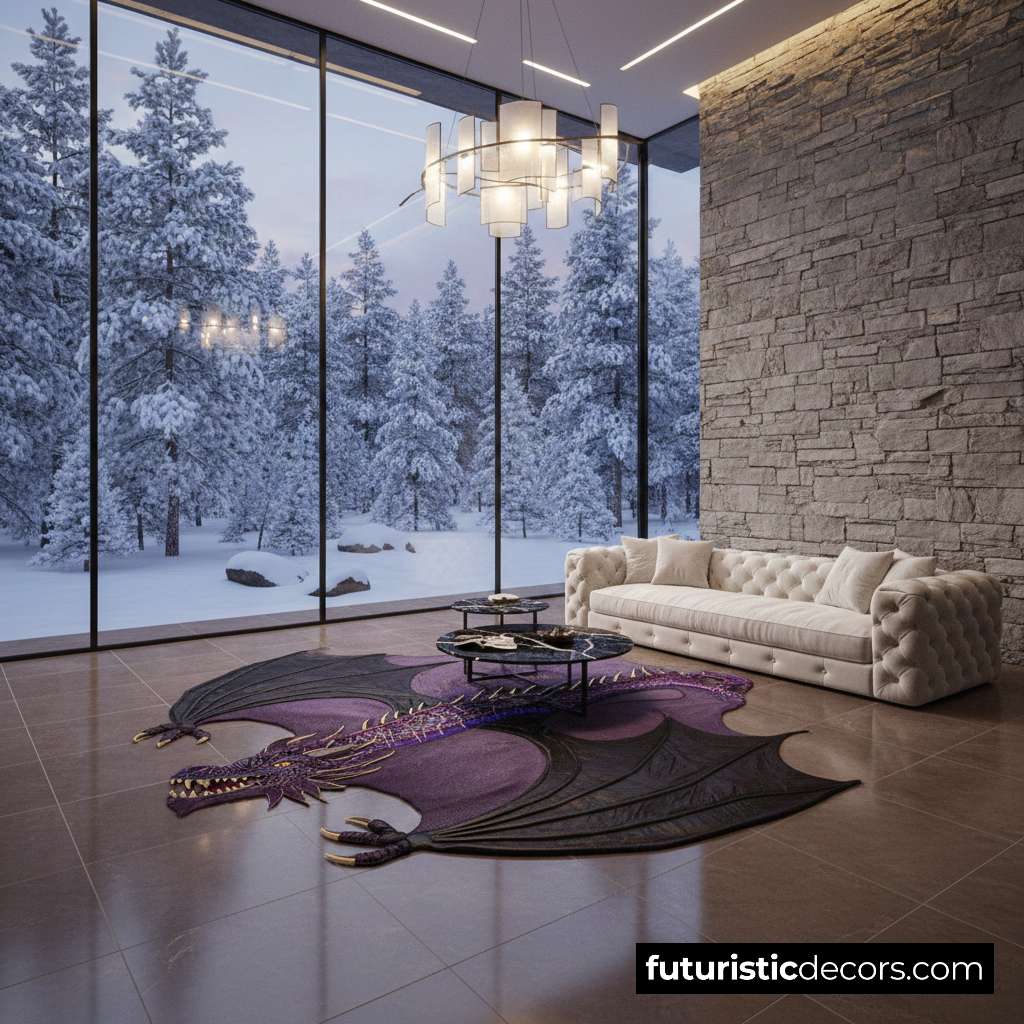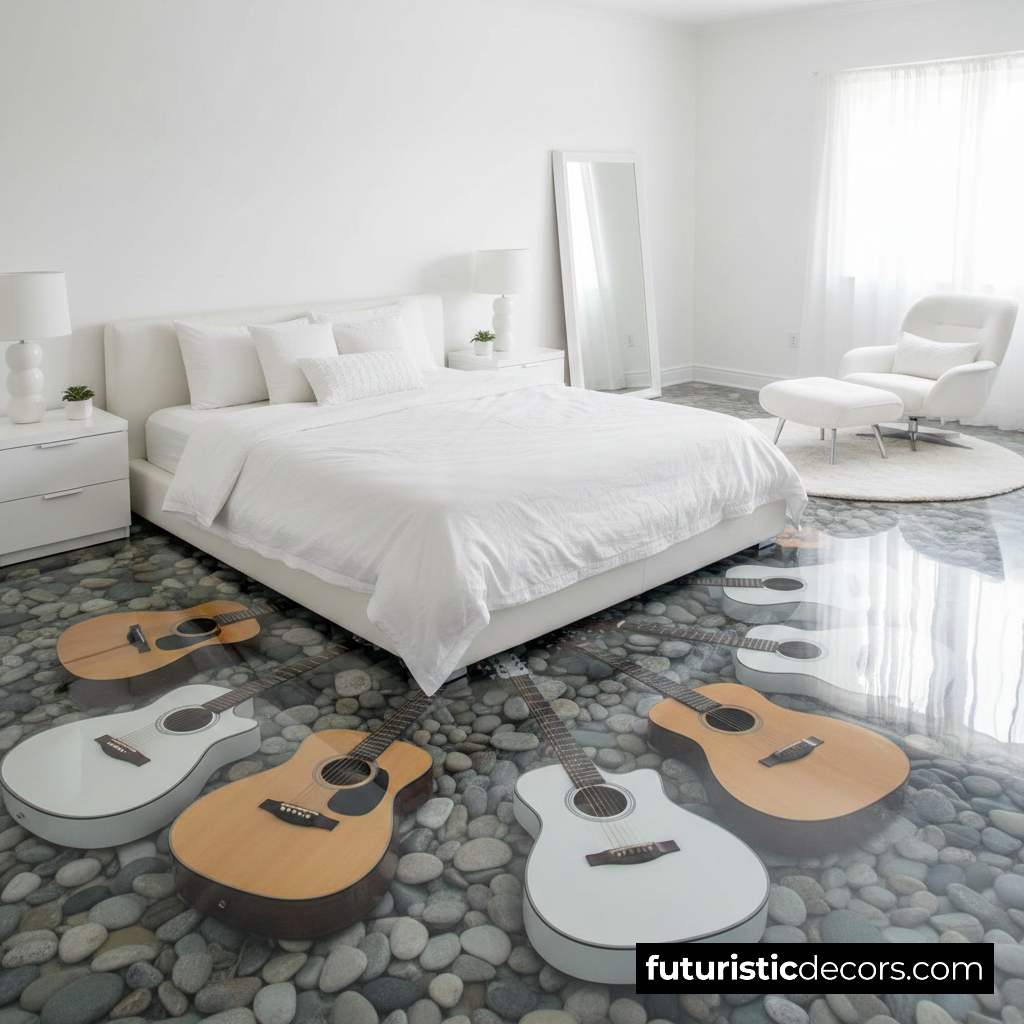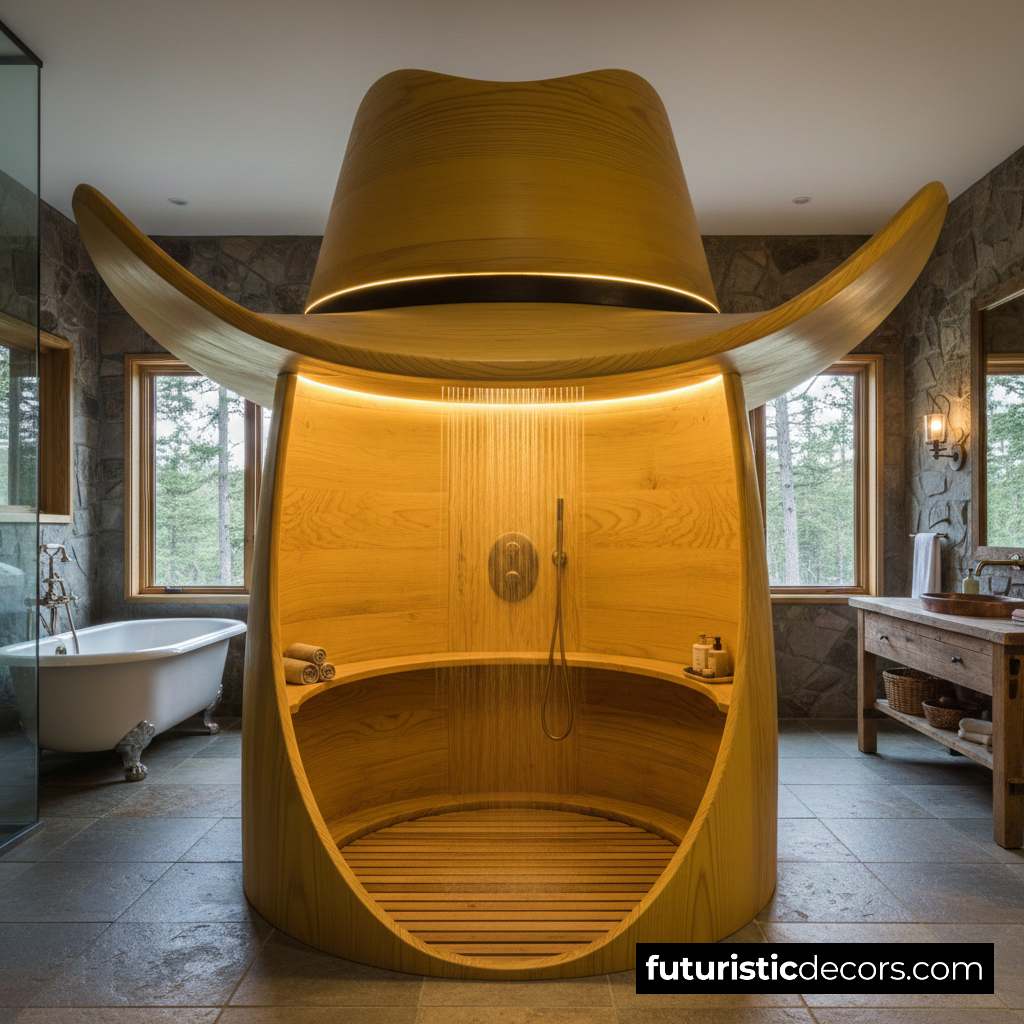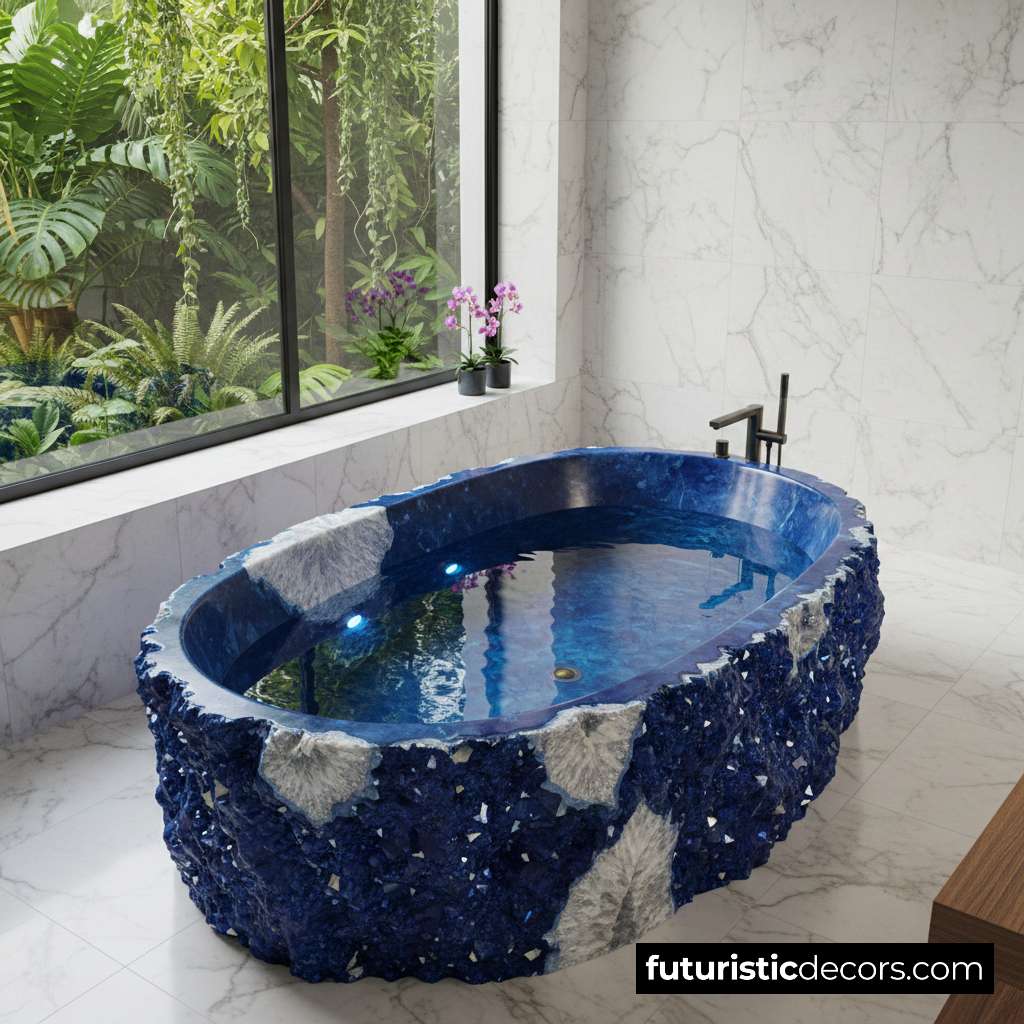Nestled among the undulating dunes of the Gobi Desert, the Tortoise-shaped House emerges as an architectural marvel that harmonizes biomimicry, sustainability, and cultural resonance. Inspired by the endurance and slow, deliberate movement of the desert tortoise, this visionary dwelling offers respite from the harsh elements while celebrating Mongolia’s rich heritage. In this comprehensive exploration, we delve into the conception, design, construction, and living experience of the Tortoise-shaped House, a groundbreaking project that redefines desert architecture.
1. Conceptual Inspiration: Biomimicry Meets Mongolian Tradition
At its core, the Tortoise-shaped House draws inspiration from two distinct yet complementary sources:
Desert Tortoise Physiology
Protective shell: The house’s outer shell mimics a tortoise’s carapace, providing insulation and defense against extreme temperatures.
Low-profile silhouette: By hugging the ground, the design reduces wind exposure and harnesses passive heating.
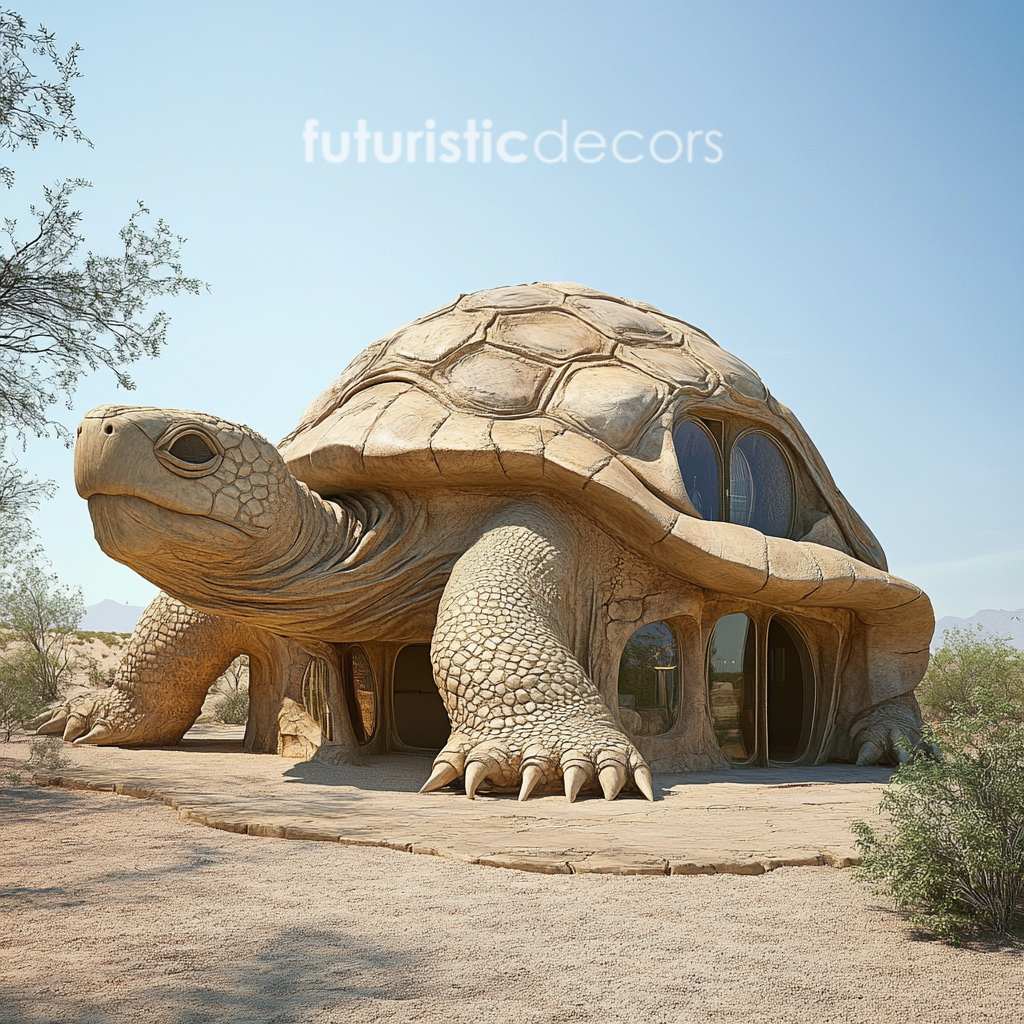
Mongolian Nomadic Culture
Ger (yurt) heritage: Incorporating circular, modular living spaces reminiscent of traditional gers fosters a sense of community and mobility.
Local craftsmanship: Utilization of indigenous building techniques and decorative motifs ensures cultural continuity.
This blend of natural form and ancestral wisdom yields a dwelling that is both functional and evocative, capturing the spirit of resilience emblematic of desert life.
2. Site Selection: Advantages of the Gobi Locale
The vast Gobi expanse poses unique challenges and opportunities:
- Extreme temperature fluctuations: Ranging from −40 °C in winter to over 40 °C in summer, the desert tests any structure’s thermal performance.
- Sparse precipitation: With annual rainfall under 200 mm, water management is paramount.
- Stunning vistas: Rolling dunes, open skies, and distant mountain ranges provide an awe-inspiring backdrop.
Choosing a south-facing slope optimizes solar gain in winter while natural dune formations act as windbreaks. Proximity to a seasonal stream bed (khad) further aids in collecting and storing the precious desert water.
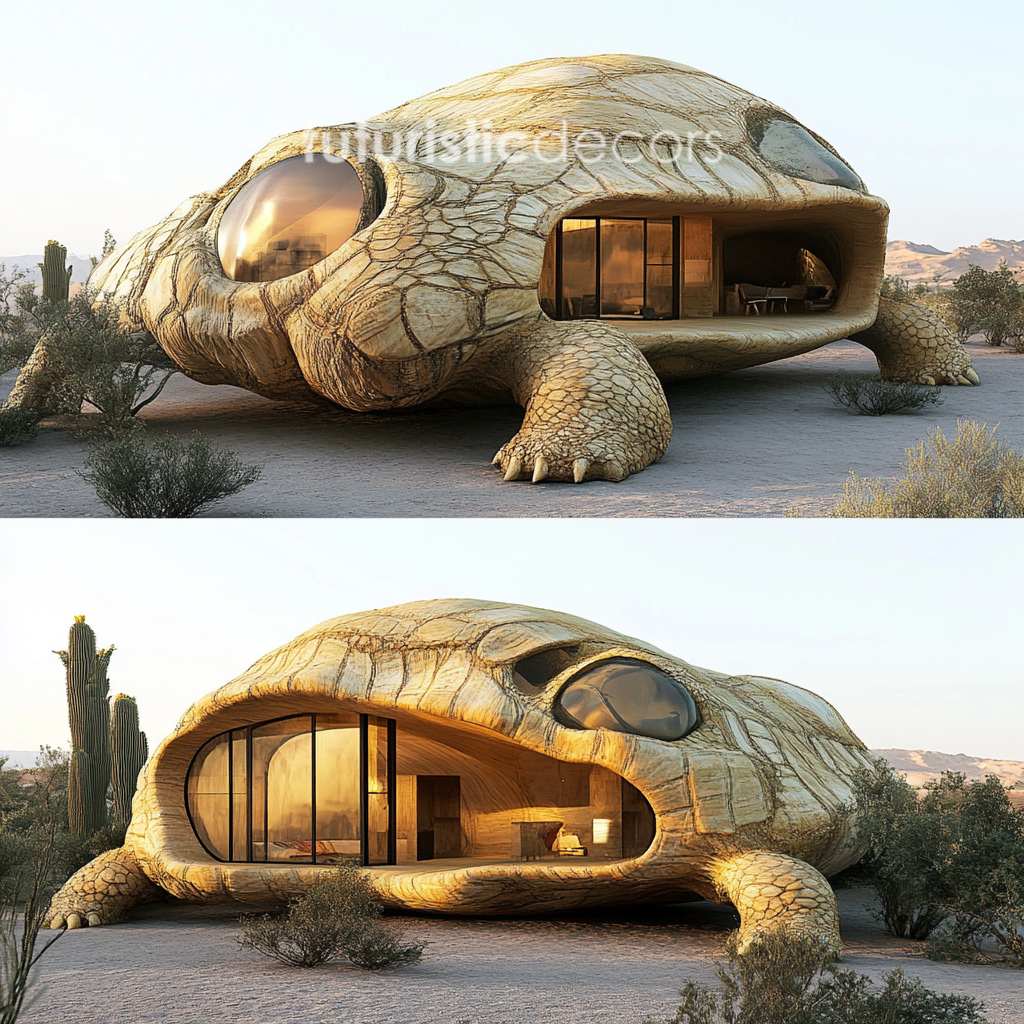
3. Architectural Form: Anatomy of the Tortoise-shaped House
The dwelling’s design can be dissected into four main components:
Outer Shell (Carapace)
Material: High-performance, fiber-reinforced concrete panels with aerogel insulation.
Geometry: A series of interlocking, hexagonal “scutes” emulate tortoise scales, allowing for modular assembly and maintenance.
Function: Shields the interior from solar radiation and sand abrasion.
Inner Core (Plastron)
Layout: Central circular living area with radial bedrooms and service niches.
Ceiling: Vaulted, utilizing laminated timber ribs to mimic tortoise bone structure, offering both strength and an organic aesthetic.
Sunken Courtyard
Purpose: Creates a protected outdoor living space, leveraging earth-sheltering to moderate temperature.
Features: Raised planters for succulents and hardy desert flora, a small reflecting pond for evaporative cooling, and retractable shade canopies.
Entry Portal (“Head” and “Legs”)
Design: Four robust concrete “leg” buttresses anchor the house, while the “head” forms a glazed vestibule oriented toward sunrise.
Function: Facilitates natural ventilation cross-flow, guiding cool morning air through the living core.
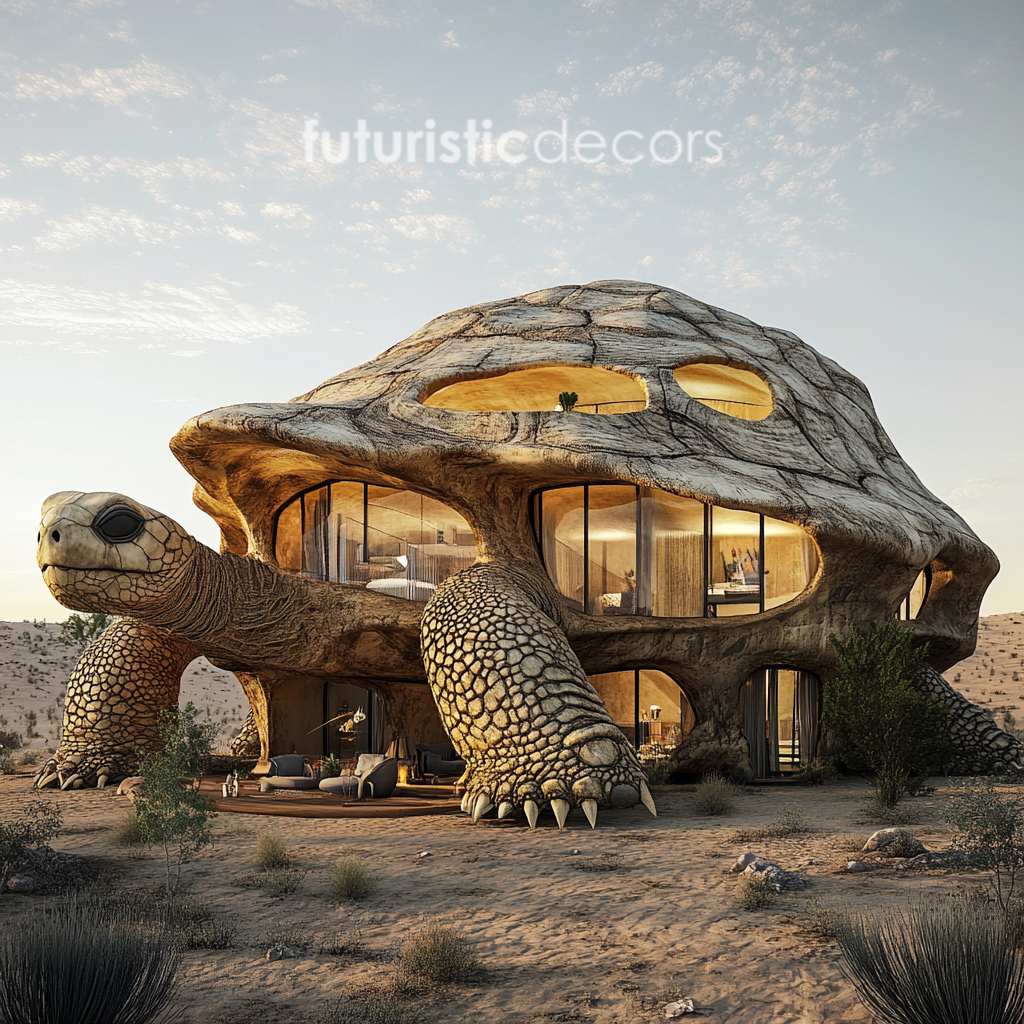
4. Materials and Sustainable Solutions: Tortoise-shaped House
Sustainability underpins every decision:
Local Materials
Stone aggregate sourced from nearby quarries reduces transport emissions.
Timber from responsibly managed Mongolian pine forests, used in interior finishes and structural members.
High-performance Insulation
Aerogel blankets placed within scute panels offer an R-value exceeding 40 m²·K/W, critical for desert extremes.
Thermal mass: The thick concrete shell stores daytime heat, releasing it at night.
Renewable Energy Systems
Photovoltaic array integrated atop scute panels produces up to 15 kW, meeting electricity needs.
Solar thermal collectors heat water for underfloor radiant systems and domestic use.
Water Management
Rainwater harvesting: Hidden gutter channels funnel occasional rain into underground cisterns.
Greywater recycling: Treated to irrigate courtyard plantings.
Together, these systems enable the Tortoise-shaped House to operate off-grid for extended periods, reflecting a commitment to minimal environmental impact.
5. Climate-responsive Strategies: Tortoise-shaped House
Thriving in the Gobi requires a nuanced understanding of its microclimate:
Passive Solar Design
Winter: South-facing glazing captures low-angle sun, warming the interior.
Summer: Operable louvered screens shade windows and facilitate stack ventilation.
Earth-sheltering
Partially embedding the structure into the dune base reduces temperature swings and provides natural anchorage against high winds.

Cross-ventilation and Night Purge
Strategically placed vents in the “head” and “tail” encourage airflow, flushing out heat accumulated during the day and drawing in cool night air.
These passive measures significantly cut reliance on mechanical heating and cooling, reinforcing the house’s eco-friendly ethos.
6. Interior Design: Marrying Functionality with Aesthetics
Inside the Tortoise-shaped House, spaces flow organically:
Central Living Dome
Open-plan: Multi-functional area combining living, dining, and cooking zones under a soaring timber canopy.
Natural finishes: Tadelakt plaster walls in sandy hues evoke the surrounding desert palette.
Radial Bedrooms
Privacy: Each suite occupies a “scale” module, with private glazing and adjustable sunshades.
Built-in furniture: Integrated benches and storage carved directly into the walls maximize space.
Service Nook
Compact bathrooms: Equipped with composting toilets and greywater treatment.
Mechanical closet: Houses batteries, inverters, and pumps, seamlessly integrated behind a decorative scute panel.
Observation Loft
Positioned above the entrance vestibule, this cozy perch offers 360° desert views through hexagonal skylights, perfect for stargazing.
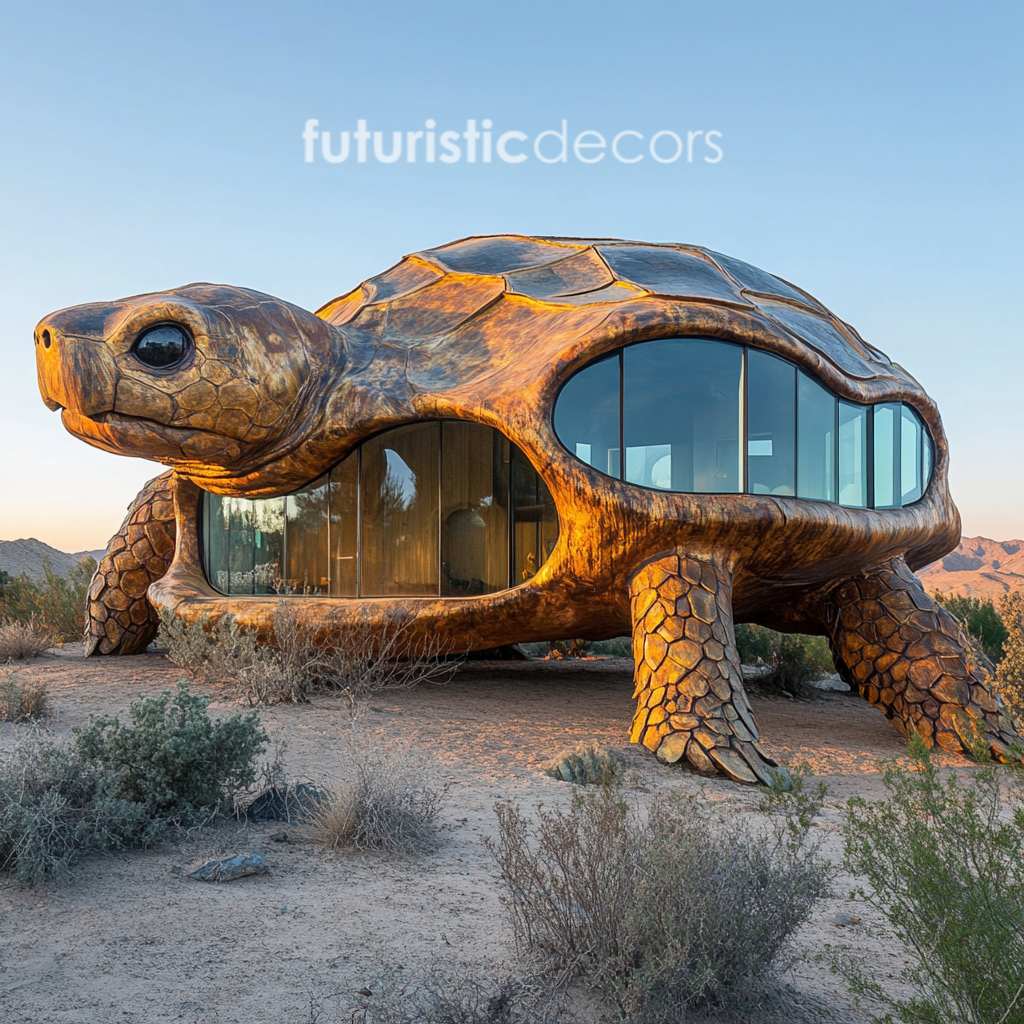
The interior palette—muted ochres, warm woods, and hand-woven textiles—imbues the home with a serene, grounded ambiance.
7. Cultural Integration and Local Engagement
Authenticity stems from community collaboration:
Artisanal Craftsmanship
Local blacksmiths forged the scute panel frames and custom door handles.
Nomadic felt-makers contributed traditional rugs, wall hangings, and insulation textiles.
Cultural Programming
The house hosts occasional workshops on desert survival, Mongolian throat singing performances in the courtyard, and open days for herding families to visit.
By valuing indigenous knowledge and fostering local employment, the project transcends architecture, becoming a cultural catalyst.
8. Engineering and Construction Challenges
Building in the Gobi demands ingenuity:
| Challenge | Solution |
|---|---|
| Remote logistics | Airdropped prefab scute modules and on-site assembly minimized transport. |
| Wind-blown sand abrasion | Quartz-enhanced concrete mix resists erosion. |
| Temperature-driven material stress | Expansion joints within scute grid absorb movement. |
| Limited skilled labor | On-site training programs upskilled local workers. |
Construction spanned two seasons: prefabrication in Ulaanbaatar during winter, and desert erection in the cooler spring months. The modular scute system allowed efficient assembly—scutes clicked together like puzzle pieces, completing the shell in under six weeks.
9. Environmental Impact and Conservation
The Tortoise-shaped House aspires to a net-positive legacy:
Minimal Footprint
Elevated walkways protect dune ecology, preventing soil compaction.
Solar and water systems ensure minimal extraction from the environment.
Biodiversity Support
Courtyard plantings feature native xerophytes, attracting pollinators and desert-adapted insects.
Nighttime lighting employs motion sensors to avoid disturbing nocturnal wildlife.
Educational Outreach
Interpretive signage details desert ecology and sustainable design principles for visiting students and researchers.
Through these measures, the house functions as both a habitat and a beacon for responsible desert stewardship.

10. Living Experience: Comfort in the Extremes
Residents and guests praise several unique features:
Thermal Comfort
Year-round indoor temperatures range between 18 °C–24 °C with zero mechanical heating/cooling.
Acoustic Serenity
The thick shell muffles sandstorms and whistling winds, creating an almost cathedral-like hush.
Astronomical Connectivity
Hexagonal skylights align with constellations, doubling as learning tools for astronomy enthusiasts.
This combination of tranquility and connectivity to the land epitomizes the vision of slow, intentional living.
11. The Tortoise-shaped House as a Tourist Attraction
Beyond private residency, the house has emerged as a sought-after retreat:
Eco-lodge component
Curated stays include guided desert treks, camel caravans, and Mongolian culinary experiences.
Architectural pilgrimage
Students of architecture and sustainable design travel from across Asia and Europe to study its innovative form.
Annual visitor capacity is capped at 300 to preserve the site’s integrity and maintain an intimate guest experience.
12. Economic Considerations and Scalability
While bespoke, the project offers a template for future developments:
- Initial investment: Approximately USD 1.5 million, reflecting high-performance materials and logistics.
- Operational savings: Zero utility bills and low maintenance costs translate to a five-year payback for lodging operations.
- Replication potential: Modular scute systems can be downsized or expanded for individual homes, research stations, or glamping sites.
Developers in other arid regions—from the Sahara to Australia’s Outback—have expressed interest in adapting the concept to local contexts.
13. Maintenance, Longevity, and Upgrades
Designed for a lifespan exceeding 100 years, the Tortoise-shaped House incorporates:
- Replaceable scute panels: Individual sections can be swapped without major demolition.
- Self-healing concrete additives: Microcapsules release sealants when cracks form, prolonging shell integrity.
- Digital monitoring: Embedded sensors track structural health, energy generation, and water usage, alerting managers to any anomalies.
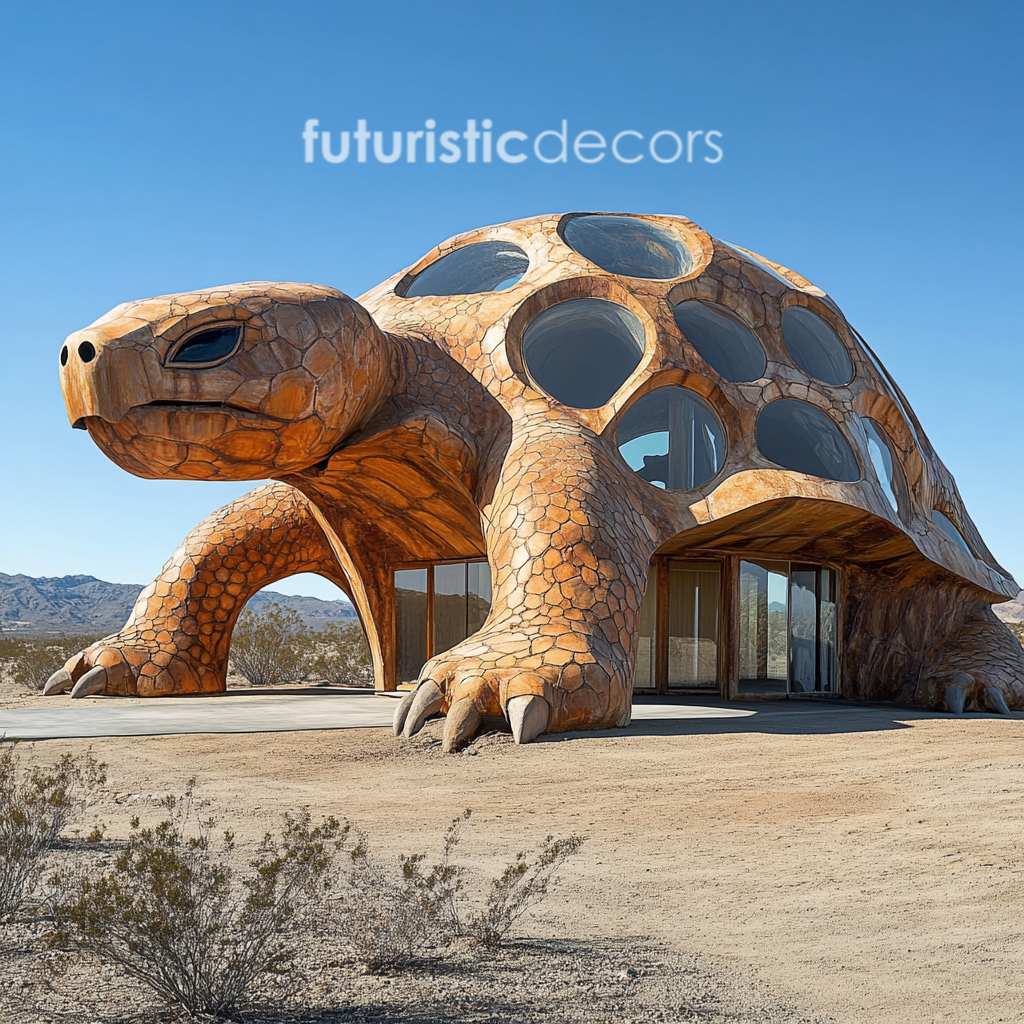
Routine inspections—scheduled biannually—ensure that the shell and core systems remain fully operational with minimal intervention.
14. Future Innovations: Beyond the Desert
Building on this success, FuturisticDecors envisions next steps:
- Adaptive color-changing exoshell: Photochromic coatings could adjust reflectivity based on solar intensity.
- Bio-inspired water harvesting skins: Hydrophilic surface textures draw moisture from fog-laden winds.
- Community clusters: Networks of interconnected tortoise houses sharing energy grids and communal agricultural pods.
These advancements promise to further blur the lines between architecture, nature, and technology.
15. Frequently Asked Questions (FAQs)
Q1: What is the approximate cost to build a Tortoise-shaped House in the Gobi Desert?
Construction budgets typically start around USD 1.3 million for a basic shell and core fit-out. Additional customization—such as high-end finishes, expanded guest suites, or art installations—can raise costs to USD 1.8 million or more.
Q2: How long does the build process take from groundbreaking to move-in?
– Prefabrication of scute modules in Ulaanbaatar: 8–10 weeks
– Desert site preparation (access roads, foundations): 4 weeks
– On-site assembly of scute shell and interior fit-out: 6–8 weeks
In total, a 5- to 6-month timeline is realistic, weather permitting.
Q3: Can the design be adapted for different family sizes or functions?
Absolutely. The modular “scute” system allows scaling:
- Compact retreat (1–2 bedrooms)
- Family residence (3–4 bedrooms plus expanded living wing)
- Commercial glamping lodge (multiple interconnected pods)
Q4: How resilient is the shell against extreme weather and sandstorms?
– Aerogel-insulated concrete scutes withstand abrasive particles and thermal cycling.
– Quartz-enhanced mix resists erosion, while maintenance crews can replace individual panels within hours if needed.
Q5: What utilities are available on-site?
– Electricity: 15 kW photovoltaic array + battery storage
– Hot water: Solar thermal collectors + backup wood-fired heater
– Water supply: Rainwater cisterns (7,000 L capacity) + seasonal stream diversion
– Sewage: On-site greywater treatment + composting toilets
Q6: Is high-speed internet or cell coverage possible?
Cell signal is typically weak. Most guests use a satellite hotspot installed in the observation loft. Fibre-optic extension from Dalanzadgad (120 km away) remains a long-term planning goal.
Q7: How is waste handled off-grid?
– Greywater is recycled to irrigate courtyard plantings.
– Blackwater is composted on-site and later used as soil amendment in non-edible landscape zones.
– Solid waste is minimized through careful packaging choices; recycling and composting stations are provided.
Q8: Are pets allowed for overnight stays?
Yes—small, well-trained companion animals are permitted. An additional deposit covers any necessary deep-cleaning of felt rugs and furniture.
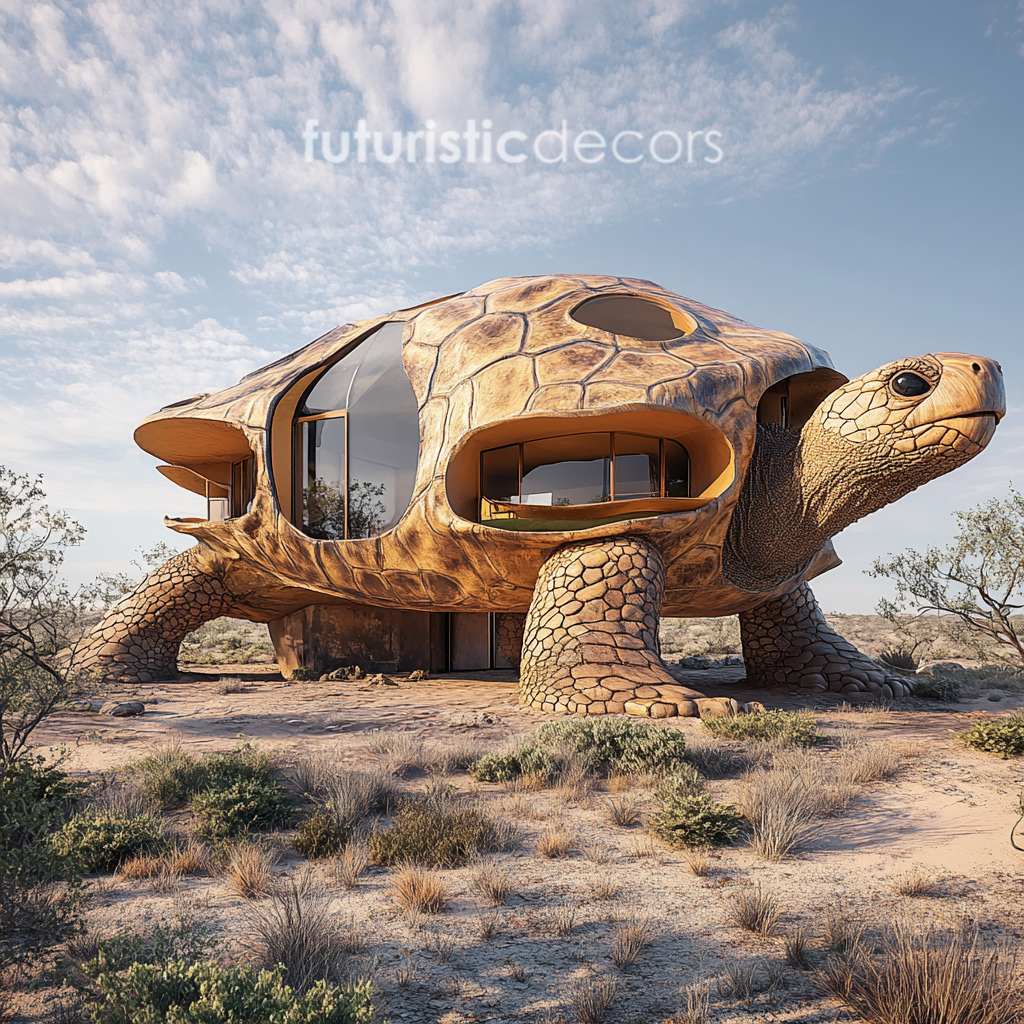
Q9: What safety measures protect occupants from desert hazards?
– Sealed entry vestibule filters out dust during storms.
– Emergency generator auto-starts if battery voltage drops below threshold.
– First-aid kits and emergency locator beacon are standard in each bedroom suite.
Q10: How accessible is the site from the nearest town?
A 4×4-equipped vehicle traverses 120 km of gravel and sand track from Dalanzadgad. During peak winter snow, access may require tracked transport or postponing travel.
Q11: Can the Tortoise-shaped House be replicated in other environments?
Yes—architects have begun adapting the scute-module concept for:
- Arid regions (e.g., Australian Outback)
- Temperate climates (with glazed scutes for daylight harvesting)
- Coastal zones (using corrosion-resistant alloys)
Q12: What permits are required for building?
– Land-use approval from the provincial (aimag) governor
– Environmental impact assessment by Mongolia’s Ministry of Environment
– Building permit from local authorities in Ömnögovi Province
16. Planning Your Visit: Tortoise-shaped House
For travelers eager to experience this architectural wonder:
Best Seasons:
Spring (April–June) – Mild temperatures (10 °C–25 °C) and blooming desert flowers
Autumn (September–October) – Crisp nights and clear skies
Booking:
Reserve through the official Tortoise House Eco-Lodge website at least 3 months in advance.
Overnight rates start at USD 450 per night for a standard suite; all-inclusive packages (meals, guided tours) from USD 750 per night.
Travel Logistics:
Fly to Dalanzadgad Airport (flight from Ulaanbaatar: 1.5 hours).
Arrange a 4×4 transfer (included in lodge packages).
Check-in at the Reception Yurt before journeying 120 km into the dunes.
What to Pack:
Layered clothing: Desert days are hot; nights can drop below 0 °C.
Sun protection: Wide-brimmed hat, high-SPF sunscreen, UV-blocking sunglasses.
Good hiking boots: Essential for dune treks and rocky outcrops.
17. Practical Tips for Prospective Builders
Engage early with local communities – Their insights on seasonal water flows and soil stability are invaluable.
Hire a prefabrication partner – Off-site manufacturing accelerates on-site work and ensures quality control.
Invest in monitoring instrumentation – Structural sensors and energy meters help optimize performance over decades.
Plan for modular growth – Even if you build a small retreat first, design foundations to support future scute additions.
Conclusion: Tortoise-shaped House
The Tortoise-shaped House in the Gobi Desert stands as a testament to what emerges when visionary design meets ecological responsibility. By mirroring the desert tortoise’s resilience and honoring Mongolia’s nomadic heritage, this dwelling transcends conventional architecture, offering a sanctuary that thrives amidst extremes. From its hexagonal scute shell to its earth-sheltered courtyard, every element speaks to a future where buildings live in harmony with their surroundings. As the world grapples with climate challenges, the Tortoise-shaped House shines as an emblem of sustainable ingenuity—proof that sometimes, slow and steady truly does win the race.
By extending the Tortoise-shaped House concept—from private eco-retreat to educational showcase—FuturisticDecors demonstrates that visionary design rooted in nature can flourish even in the planet’s most forbidding environments. Whether you’re an architect, traveler, or sustainability enthusiast, this desert dwelling offers lessons in resilience, harmony, and the enduring power of biomimicry.


